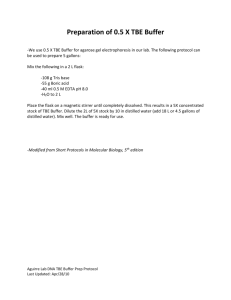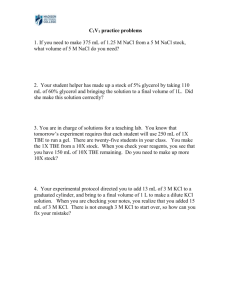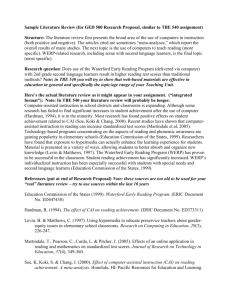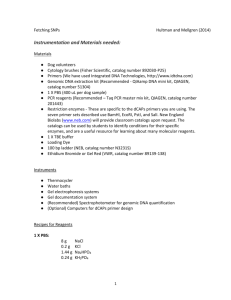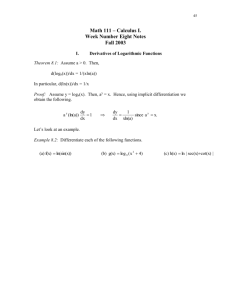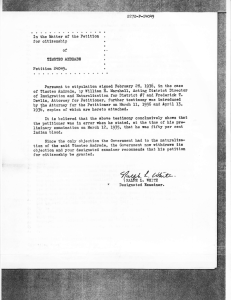Article 7 - Discovering New Points of Differentiation
advertisement
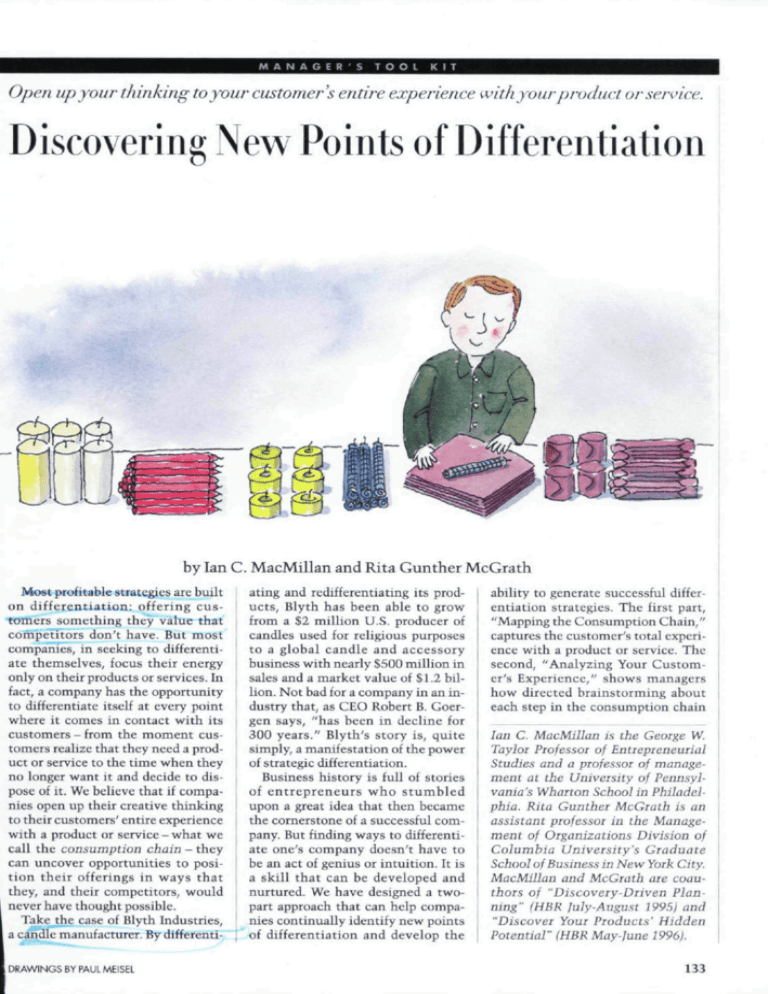
M A N A O F R ' S T O O l K I T Open up your thinking to your customer's entire experience with yourproduct or service. Discovering New Points of Differentiation by Ian C. MacMillan and Rita Gunther McGrath Most profitable strategies are built on differentiation: offering customers something they value that competitors don't bave. But most companies, in seeking to differentiate themselves, focus their energy only on tbeir products or services. In fact, a company has tbe opportunity to differentiate itself at every point where it comes in contact with its customers - from the moment customers realize that they need a product or service to tbe time when they no longer want it and decide to dispose of it. We believe tbat if companies open up their creative thinking to their customers' entire experience with a product or service - what we call tbe consumption chain - they can uncover opportunities to position their offerings in ways that they, and their competitors, would never have thought possible. Take the case of Blyth Industries, a candle manufacturer. By differentiDRAWINGS BY PAUL MEISEL ating and redifferentiating its products, Blyth has been able to grow from a $2 million U.S. producer of candles used for religious purposes to a global candle and accessory business with nearly $500 million in sales and a market value of $1.2 billion. Not bad for a company in an industry that, as CEO Robert B. Goergen says, "has been in decline for 300 years." Blyth's story is, quite simply, a manifestation of the power of strategic differentiation. Business history is full of stories of entrepreneurs who stumbled upon a great idea tbat then became the cornerstone of a successful company. But finding ways to differentiate one's company doesn't have to be an act of genius or intuition. It is a skill that can be developed and nurtured. We have designed a twopart approach that can belp companies continually identify new points of differentiation and develop the ability to generate successful differentiation strategics. Tbe first part, "Mapping the Consumption Chain," captures the customer's total experience witb a product or service. The second, "Analyzing Your Customer's Experience," shows managers how directed hrainstorming about each step in the consumption chain Ian C. MacMillan is the George W. Taylor Professor of Entrepreneurial Studies and a professor of management at the University of Pennsylvania's Wharton School in Philadelphia. Rita Gunther McGrath is an assistant professor in the Management of Organizations Division of Columbia University's Graduate School of Business in New York City. MacMillan and McGrath are coauthors of "Discovery-Driven Planning" (HBR July-August 1995} and "Discover Your Products' Hidden Potential" (HBR May-fune 1996). 133 M A N A G E R ' S T O O L K I T Otal-B created a powerful source of differentiation with a toothbrush that tells customers when they need a new one. can elicit numerous ways to differentiate even the most mundane product or service. ( Mapping the Consumption Chain As we've said, the first step toward strategic differentiation is to map your customer's entire experience with your product or service. We recommend tbat companies perform this exercise for each important customer segment. To begin, assemble groups from all areas of your company - in particular, those employees who use marketing data and those who have they first become aware of your product to the time when they finally have to dispose of it or discontinue using it. Naturally, every product or service will have a somewhat different consumption chain. However, a few activities are common to most chains. Consider tbe following questions, eacb of which illustrates one of those activities. Then, as the group hegins to get a feel for the special relationship between your customers and your products, ask questions about more complex activities that pertain to your business. How do people hecome aware of their need for your product or service? Are con- sumers aware that you can satisfy their need? Are they aware that they even have a need tbat can be satisfied? Your company can create a powerful source of differentiation if it can make consumers aware of a need in a way that is unique and subtle. The first step is to map your customer's entire experience vs^ith a product. face-to-face or phone contact with customers. Charge the groups with identifying, for each major market segment, all the steps through which customers pass from the time 134 Consider the problem of differentiating an everyday consumer prod- uct, such as a toothbrush. For many people, brushing is a ritual to which they pay relatively little attention. As a consequence, many brushes are used well past the point wben tbeir bristles are worn and are no longer effective. Toothhrush maker Oral-B discovered a way to capitalize on this widespread habit. The company, hy introducing a patented hlue dye in the center bristles of its toothbrushes, found a way to have the brush itself communicate to the customer. As the brush is used, the dye gradually fades. When tbe dye is gone, the brush is no longer effective and should be replaced. Customers are thus made aware of a need that previously had gone unrecognized. So far, the idea sounds like something out of Marketing 101. What gives it particular value is that the need can he filled only hy Oral-B's patented process. The company turned differentiation into a competitive advantage. How do consumers find yonr of- fering? Opportunities for differentiating on the basis of the search process include making your prodHARVARD BUSINESS REVIEW [uly-August 1997 M A N A G E R ' S T O O L K I T uct available wben otbers are not (24-hour telephone-order lines), offering your product in places where competitors do not offer theirs (the mini McDonald's outlets in WalMart stores), and making your product ubiquitous (Coca-Cola). Making the search process less complicated, more convenient, less expensive, and more habitual are all ways in which companies can differentiate themselves. And when competitors can't or won't do the same - at least, not right away-you have the potential for a strategic advantage. One example is the rapid growth of catalog sales in channels formerly dominated by retail chains. Consumers now can ohtain detailed, upto-the-minute information about a breathtaking range of products over the telephone or through the Internet, without enduring the inconvenience of visiting a showroom and the often inadequate knowledge of the floor sales staff. The PC Connection & Mac Connection, a company that sells computers through its catalog, operates a 24-hour-a-day, seven-day-a-week toll-free pbone number for people wanting information about computers, software, and related products. When a caller expresses an interest in buying a computer system, a company representative asks a set of questions to narrow from selcctmg their products, while Tbe terminals connected those cusyour procedures encourage people to tomers directly to tbe company's come to you. Citibank for years capsystem, allowing direct drop shiptured a significant share of the colment and automatic restocking lege student market for credit cards whenever supplies fell below a cersimply by making it easy for stutain level. Hallmark uses a similar dents to ohtain a card while comapproach for its greeting cards. petitors made it difficult. Many companies, including iceAnother example of tbis dynamic cream makers and pet-food manuis playing out right now in the usedfacturers, are also using tbis method car business. For many potential to stock supermarket shelves, reapcustomers, the experience of choosing the benefits of preferred access ing a used car is an ordeal - to the point where one CEO of a CarMax and AutoNation major automaker observed that some peo''selP' cars by letting ple would rather have customers create their a root canal. But a new method of selecting selection process. cars is transforming the industry. Companies such as CarMax Auto Superto these crucial outlets as well as store and AutoNation USA bave tarof superior displays. Another, more geted the selection experience as subtle benefit of this form of diftheir competitive focus. At a Carferentiation is that it imposes a Max showroom, customers sit in switching cost on customers tbat front of a computer and specify what might be tempted to try another features they are looking for in an supplier. Once customers have automobile. They can then, in prisigned on, it is expensive for them vate, scroll through detailed descripto switch; tbis deterrent creates a tions of cars tbat might meet tbeir barrier to competition and, once needs. Tbe final (and only) price for again, a potential strategic advaneach vehicle is listed. A sales assistage for the supplier. tant tben lets the customers inspect How is your product or service dethe autos that interest them and livered? Delivery affords many ophandles all the paperportunities for differentiation, espework if they decide to cially if the product is an impulse buy one. The "selling" is Ian you make the buying done not by the salespeo- purchase or if the customer needs it immediately. Let's return to our but by the selection process more convenient ple catalog computer dealer, the PC process the customers Connection. Customers can call its create for themselves. and less irritating? toll-free number as late as 3 A.M to receive "next-day" shipments of How do customers oritems in stock. How does tbe comdown the possibilities to a few good der and purchase your product or pany do it? The amazing turnaround candidates. The rep and the conservice? This question is particulartimes are possible because the waresumer then can discuss each option ly important for relatively low-cost, housing and distrihution facilities in detail. What is remarkable about high-volume items. Can a company are conveniently located near an this approach is that, in effect, it differentiate itself by making the Airborne Express hub. Packages can allows consumers to tailor the search process of ordering and purchasing be picked up at the warehouse, experience to their own needs. more convenient? transferred to Airborne, and shipped How do consumers make their fiAmerican Hospital Supply revoluto the customer in a matter of hours. nal selections? After a consumer has tionized its industry by radically Not only does this delivery strategy narrowed down the possibilities, he simplifying the ordering and reconstitute a real benefit for cusor she must make a choice. Can you stocking process for such products tomers, but, because there are a limmake the selection process more as bandages, tongue depressors, syited number of opportunities for comfortable, less irritating, or more ringes, and disinfectants. The comsuch a warehouse-hub connection, convenient? Look for the ideal situapany installed computer terminals competitors will find it hard to adopt tion, in which competitors' proceat each hospital and medical supply tbe same strategy, dures actually discourage people store with which it did business. HARVARD BUSINESS REVIEW July-August 1997 135 M A N A G E R ' S What happens when youi product or service is delivered? An often overlooked opportunity for differentiation lies in considering what has to happen from the time a company delivers a product to the time the customer actually uses it. Opening, inspecting, transporting, and assembling products are frequently major issues for customers. That applies even to the delivery of services. Consider how difficult it can be to get an auto accident claim processed and paid by an insurance company. Now consider how Progressive Insurance of Cleveland, Ohio, tackled the problem. The company has a fleet of claims adjusters on the road every day, ready to rush to the scene of any auto accident in their territory. There they can record all the information they need and often settle claims on the spot for policyholders. The process has greatly increased customer satisfaction by eliminating the hassle and delay that so often accompany conventional reporting, inspection. T O O l and assessment methods. A side benefit for the company is tbat its approach also has decreased the incidence of fraud by reducing the opportunity to file false claims and inflate repair bills. How is youi product installed? This step in the consumption chain is particularly relevant for companies with complex products. For example, installation has presented an enormous barrier for computer manufacturers trying to break into tbe novice-PC-user market. Computer beginners are notoriously intolerant of such on-screen messages as "Disk Error 23." Compaq Computer, witb its Presario line, was among the first to target installation as a source of differentiation. Instead of providing an instruction book filled with technical terminology, Compaq offers its customers a poster tbat clearly illustrates the ten installation steps. The company uses color-coded cords, cables, and outlets to simplify installation further and also bas rigged its Compaq discoveied a valuable way to differentiate itself: it provides customers with a user-friendly installation video. 136 K I T computers so that a cheerful video and audio presentation leads new users through the setup and registration process when tbey first turn on the macbine. How is your product or service paid for? Many companies unwittingly cause their customers major difficulties with their payment policies. Here's a test to see whether payment might be sucb an issue for your customers: Take a walk over to your accounts-receivable department and ask to see a copy of a recent invoice. If your company is anytbing like about 80% of those we bave worked witb, tbe invoice will be virtually incomprehensible. Why? Because invoices are generally designed by systems people for systems, not customers. Given the prevalence of tbis situation, your company may find opportunities to set itself apart by making tbe wbole payment process easier for customers to understand. You may discover even greater opportunities by rethinking wby your company uses its current payment policy in tbe first place. We once worked with a company in the energy control business tbat was having a hard time selling its services to residential co-op owners. At every coop, tbe company ran into opposition from a bard core of owners who resisted the capital outlay involved in installing an energy management system. Tbe company eventually won a huge share of the co-op market by altering its policy, Customers no longer pay an up-front installation fee; instead, they pay over time, out of tbe energy savings. How is your product stored? Wben it is expensive, inconvenient, or downright dangerous for customers to bave a product simply sitting around, tbe opportunities for differentiation abound. Air Products and Chemicals, a producer of industrial gases, grew to dominate its market segments by addressing tbe problem of storage. Realizing that most of its customers - cbemical companies-would ratber avoid the burden of having to store vast quantities of dangerous higb-pressure gases. Air Products built small industrial-gas plants next to customers' sites. The HARVARD BUSINESS REVIEW luly-August 1997 M A N A G E R ' S T O O L K I T move pleased customers; it also generated switching costs. Best of all, once an Air Products plant was in place, competitors bad little opportunity to move in. How is your product moved around? Wbat difficulties do customers encounter when they must transport a product from one location to another? Whether the journey is across a room or across a state, this step in the consumption chain is another often-overlooked opportunity for differentiation. Ask yourself the following questions: Does the customer find the product fragile? Difficult to package? Awkward to move: Consider how John ScuUey's marketing team at Pepsi-Cola used packaging as a way to differentiate Pepsi from Coke. Sculley's team created a distinct-if temporary-advantage for Pepsi in the early 1970s by designing plastic bottles tbat were ligbter, and thus easier for customers to carry, than tbe heavy glass bottles of tbe time. The beauty of the move was that it not only made carrying soda easier, but it also reduced the advantage of Coke's wellknown contoured glass bottle. At the time, it was difficult to produce plastic bottles in that shape. What is the customer really using your product for? Finding better ways for customers to use a product or service is a powerful differentiator. And such opportunities abound, especially for companies whose products are expensive and used relatively infrequently. General Electric's Transportation Systems division, wbicb manufactures dieselelectric locomotives, used this step in tbe consumption cbain as the basis for rethinking its business. With few exceptions, the railroads that are the customers for GE's locomotives are not all tbat attached to a particular unit. What tbey really want to know is, if tbey bave freight to ship, will a locomotive be there to haul it ? GE is working on an arrangement through which the company will guarantee that a locomotive will be available on demand. Under tbat arrangement, GE will take over the management of all tbe engines in the customer's system. It will reHARVARD BUSINESS REVIEW fuly-August 1997 Nordstrom takes its no-questions-asked return policy seriously, and the result is strong customer satisfaction. lieve the customer of repair and maintenance concerns, and also will gain economies of scale by managing an entire network. What's more, the entry barrier created by such a system can be formidable. What do customers need help with when they use your product? Tbe company witb the most belpful response has a significant advantage bere. GE, for instance, has an enormously popular 800 number that is available 24 bours a day to belp people wbo bave difficulty using any of tbe company's consumer products. Similarly, Butterball Turkey's 24hour hot line fields cooking questions from hundreds of customers every Thanksgiving. Butterball has recently supplemented its hot line with an Internet home page and a turkey-cooking guide that its customers can download. What about returns or exchanges? Too many companies put all their efforts into the selling side of the product life cycle, forgetting that long-term loyalty requires attention to customers' needs throughout their experience with a product. Handling things well wben tbe product doesn't work out can be as powerful as meeting tbe need that motivated tbe initial purcbase. Nordstrom is an excellent example of a company tbat bas taken this issue to heart. The clothing retailer captured national publicity in the 1970s when one of its store managers "took back" a set of tires from a customer despite the fact tbat Nordstrom did not sell tires. By focusing on and aggressively promoting its no-questions-asked return policy, Nordstrom has enhanced its position as a company that provides unique customer service. Customers may be unbappy with tbe brands they return, but they are not unhappy with the store. How is your product repaired or serviced? As many users of hightech products will attest, repair experiences - both good and bad - can influence a lifetime of subsequent purchases. 137 IT BEGAN AS A LETTER TO HIS GRANDCHILD. Now IT'S MUST READING EOR YOU, TOO. At age 72, with a pacemaker checking his heart rhythms, Gordon Cain became an entrepreneur. He revolutionized an industry. Made more than $100 million for himself. Made millionaires of more than 100 managers. Shared millions more with employees in profit-sharing and ESOPs. Then he wrote an autobiography. It reminds us of what's right about American business. Everybody Wins! A Life in Free Enterprise by Gordon Cain $24.95 Available at bookstores or from Chemical Heritage Foundation 315 Chestnut Street Philadelphia. PA !9106'2702 Ph: 888-224-6006 Fax. 215-925-1954 http://www.chemheritage.org Mention Prioritv Code H "Gordon Cain is my Ail-American." Jon M. Huntsman. Chairman and CEO, Huntsman Corp. "The perfect antidote to cynicism about America's tree enterprise system." Edward H. Crane III. President. Cato Institute "I commend this book to you." Michaei C. Jensen. Harvard Business School Investment Opportunities & Strategies for Trading Today's Foreign Exchange Markets SUPERIOR Selection of Managed Accounts OUTSTANDING Analysis for All Major Currencies EXCEPTIONAL Execution Forex or Futures FREE Trading Software & Price Data I Peter G. Catranis COMMISSION Professional Trader Forex & Futures Specialist COMMISSION Spot FX2-5 Pip Price Spreads Futures $12-S36 Per Round-Turn Call Toll-Free Today and Learn How You Can Put My 19 Years of Professional Trading Experience to Work Directly for You Australia 1800125944 980120837 Colombia France 0800902246 Ireland 1800559294 Korea 0038110243 M Antilles 18009945757 0800996337 S. Africa Thailand 00IK001I9230666 Belgium 0800I5H80 Cyprus 08090605 Grme 00800119213013 Imel 1771000102 iiaemboarg 01*004552 N.Zealand 0SOO44I880 Spain mmmi Turkey 00800139219013 Bermuda Denmark Germany Italy Mexico Portugal Sweden 18008784178 80016132 0130829666 167875928 958008784178 050112632 020793158 Vniled Kingdom mmmP. Brazil 0008119215513 Finland 08O0I1IOO64 Hong Kong 800967209 Japan 0031126609 Netherlands 060220657 Singapore 8001202501 Switzerland 08(HI8')7233 Vnited States mm^il^'l US-Toll Voice Line+714-376-8020 . US-Toll Fax Line+714-376-8025 An ideal solution, used by Tandem Computers - a company that makes computers with parallel central-processing units for applications in which downtime is a major problem - is to try to repair a product even hefore the customer is aware that such service is needed. Tandem staff memhers can spot a malfunctioning component through remote diagnostics, send the appropriate part and instructions to the customer by express mail, and walk the customer through the repair process on the phone. This approach has almost completely eliminated expensive and inconvenient downtime for the company's customers; it also has eliminated their need for a costly onsite service force. Otis Elevator uses remote diagnostics in a different way. In high-traffic office buildings, where servicing elevators is a major inconvenience to occupants and visitors alike, Otis uses its remote-diagnostics capabilities to predict possible service interruptions. It sends employees to carry out preventive maintenance in the evening, when traffic is light. What happens when your product is disposed of ot no longer used? In a world in which it is becoming increasingly economical simply to replace many products as they age rather than spend the money to fix them, what do customers do with the obsolete goods' Canon offers an interesting example of how a company can differentiate itself at this step in the chain. It has developed a system that allows customers to return spent printer cartridges at Canon's expense. The cartridges are then rehabilitated and resold as such. The process makes it easy for customers to return used cartridges: all they need to do is drop the prepaid package off at a United Parcel Service collection station. At the same time, it enhances the image of Canon as an environmentally friendly organization. Analyzing Your Customer's Experience Although mapping the consumption chain is a useful tool in itself, the strategic value of our approach continued on page 143 M A N A G E R ' S lies in the next step: analyzing your customer's experience. The ohjective is to gain insight into the customer by appreciating the context within which each step of the consumption chain unfolds. It is crucial to remember that the customer is al- T O O ! ' company seeks tu do is he the first to create and then dominate many small niches in rapid succession over time, gaining economies of distrihution and scale hy the sheer numher of products it has in the marketplace. Consider some of the possibilities that Blyth employees uncovered when they applied the questions to their business: What? What are customers doing at each point in the consumption chain- What else would they like to he doing? What problems could they be experiencing? (These prohlems may not be directly related to your product or service.) Is there anything you can do to enhance their experience while they are at this stage of the chain? Candles, when you think about it, can play a role in everyday life in a host of different ways. Among other things, they are used to celebrate birthdays, create a festive atmosphere for dinner parties, warm buffet dishes, cope with power outages, and set the mood for romantic evenings. Candles can be purchased in specialty shops, at crafts fairs, in supermarkets, and at card stores. Further, their use can be accompanied by a huge variety of containers, displays, accents, and mood-creating products. All this suggests that candle makers might do well to explore the possibility of offering a complete "candlelight experience" by producing or marketing complementary products as well. o analyze your customer's experience, consider hovsr ve simple questions apply at each link in the chain. ways interacting with people, places, occasions, or activities. Those interactions determine the customer's feelings toward your product or service at each link in the chain. When they are viewed strategically, they can shape the dynamics of competition for tbat customer's business. Essentially, this step involves considering how a series of simple questions-what, where, who. when, and how-apply at each link in the consumption chain. We have found that the most rewarding way to approach this exercise is to have a group of people from a company start down a path with any of their questions and brainstorm until their ideas dry up. Sometimes a given question will not lead to any particular insight. That's not a problem; the goal is to assemhle an inventory of possible points of differentiation. Once the ideas are on the tahle, you can assess each one and select those that are most promising for your situation. Blyth Industries, the candle manufacturer we mentioned earlier, provides a good example of how analyzing your customer's experience works in practice. By exploring the options raised by their analysis, Blyth employees were able to take a prosaic product that is easy to imitate and create a profitable competitive advantage. What is important to understand here is that Blyth makes no pretense of being able to create the fahlcd "sustained competitive advantage" - so beloved of strategy texts - in any single segment of the candle market. Rather, what the HARVARD BUSINESS REVIEW fuly-August 1997 children's birthday parties, and in places of worship. What quickly became evident to Blyth was that the concerns and behavior patterns of its customers were likely to be different in each location. That insight suggested the potential for differentiation on the basis of location. For example, consider how candles are used in the home. Virtually every room in the house has potential: the dining room, living room, kitchen, bedroom, bathroom, and basement can all conceivably provide a setting for candle use, each for a different reason. Who? Who else is with the customer at any given link in the chain? Do those other people have any influence over the customer? Are their thoughts or concerns important? If you could arrange it, who else might he with the customer? If you could arrange it, how might those other people influence the customer's decision to buy your product? Honing in on the line of thinking Blyth used about domestic candles, consider the use of candles in the dining room. Who else is going to be Candle makers might explore the possibility of offering a complete "candlelight experience.' Where? Where are your customers when they arc at this point in the consumption chain? Where else might they be? Where would they like to be? Can you arrange for them to be there? Do they have any concerns about their location? Because candles can have so many uses, it isn't surprising that there are as many potential places for their use. Candles can be found at the beach, on picnics, at proms, at weddings, at home, in restaurants, at there? The other people could be members of the immediate or extended family, business associates, close friends, or a suitor. Each type of person means a possible point of differentiation; each type means a different experience, a different mood, and a different time. When? When-at what time of day or night, on what day of the week, at what time of the year-are your customers at any given link in the chain? Does this timing cause any problems? If you could arrange it, when would they be at this link? Take the scenario of a dining room with the family. Blyth found that the question when uncovered a wealth of opportunities for differentiation. Candles are used in the dining room 143 M A N A G E R ' S T O O L K I T Is There a Way to Differentiate Selling Gas? Consider the ''purchase link" of the consumption chain. If you pursue tbe business-trip option, the fiexf question is, Whom are they ^ t h when they buy gasoline on a business trip? Your customer could be alone or accompanied by a colleague. He or she could be with a spouse or significant other. Your customer also could be traveling with a group of people. What else are your customers doing when they buy gasoline? Among other things, they might be commuting, on a leisure trip, on a business trip, on vacation, shopping, or planning to use equipment [such os a mower or a tiller). If you pursue the idea that your custorm is olone, the next question is. Where does your customer buy gasoline "while he or she is on th business trip? Your customer might stop first at a local gas station, then again between cities along the way. with the family on birthdays, anniversaries, holidays, and graduation days, and at meals marking other special occasions. Each occasion provides a distinct experience. Important for a candle maker, each also triggers distinct emotions. Blyth employees were able to identify what became several successful new areas of differentiation by exploring how Candles intended for use with family members at Thanksgiving, for example, might be scented with cinnamon, colored in tones associated with the holiday, and sold with special holders. Because there are many holidays and other occasions wben families get together in the dining room, you can hegin to get a sense of the opportunities available for differentiation. Moreover, the process can he repeated for as many different companions and settings as the imagination of your employees can contemplate. Blyth, for example, also has found a tremendous opportunity to differentiate its products for romantic meals. CEO Goergen has worked hard to design scented candles in various shapes in order to influence the ambience of such occasions so that, as Even a simple product such as gasoline can be differentiated. their candles might be designed in special shapes, colors, or scents. They also came up with a variety of ways to package the candles and combine them with such accessories as napkins to suit each situation. 144 he says, "eating becomes dining, and dining becomes romance." How? How are your customers' needs being addressed? Do they have any concerns about the way in which your company is meeting their needs? How else might you attend to their needs and concerns? Think about how candles are used outdoors - say, at a company barbecue. Citronella candles come to mind. In addition to creating a festive atmosphere, they are an attractive way to protect people from insect bites. As we've seen, there is considerable potential for differentiation even in products so simple that at first blush they seem like commodities. Candles are but one. Gasoline is another. (See the exhibit "Is There a Way to Differentiate Selling Gas?") Understanding the customer's experience at any link in the chain for HARVARD BUSINESS REVIEW July-August 1997 M A N A G E R ' S T O O L K I T Which leads to: Does your customer have any concerns in any of those situations, and how is your conipany addressing them? Among other things, your customer might worry about getting lost or running out of gos. Or he or she might be concerned obout personal security. Also, your customer certainly doesn't want the car to break down. Keeping those ideas in mind, consider When does your customer buy gasoline? Anytime; during the day or night; during the week or on the weekend. any product offers companies the opportunity to identify and explore many nontraditional ways to create value. The task then becomes selecting from among this wealth of possibilities; considering how each idea If you consider in depth the concern about personal security, one way to differentiate the process of selling gosoline would be to reconfigure the structure of your gas stations along those highways that are principal business routes. For example, you could D ensure thot your station is well lit and monitored; D provide on ottendant to pump the gas; • provide 0 "travel adviser" at each station who has a detailed knowledge of the area; such a person might be oble to odvise your customer about the safest routes, areas under construction, congested oreas, and good restauronts and hotels; • arrange for customers who buy gas to rent a mobile phone at the gas station, possibly negotiating with the phone company to share usage revenues. so and how quickly competitors can respond. Robert Goergen knows that Blyth Industries has certain strengths its competitors do not, including several unique production techniques and, more important, a deep knowledge of fraThose special Consider ho>v each idea grances. strengths, coupled with a meshes v/ith your solid understanding of customers based on marcompany's skills, ket research, give Biyth edge. Goergen thus assets, and systems. an evaluates opportunities for differentiation based on those meshes with a company's particular considerations and moves forward skills, assets, and systems; and foonly with the ideas that promise the cusing only on those that can generstrongest returns. ate a competitive advantage. Each idea also may open up an opportuniFocused Creativity ty to develop a new competence. Too many companies pursue what Virtually every company we have seem like great new ideas without ever worked with has within it carefully assessing whether their scores of people of considerable creorganizations are well suited to do ativity and imagination. UnfortuHARVARD BUSINESS REVIEW July-August 1997 nately, all too often, the company never benefits hecause that talent isn't appropriately focused. It may even be squelched by tbe homogenizing pressures that any large organization tends to impose. An important benefit of the process we've outlined ahove is that it unlocks the creativity in an organization so that the insights of particular individuals can contribute to a shared understanding of the customer - so that the company, in effect, knows its customers almost better than they know themselves. Companies that do this successfully find themselves deeply attuned to their markets. And, like entrepreneurs, they spend the imagination they have in lieu of the money they may lack to outperform competitors wherejt counts. y Reprim 97408" To order reprints, sec the last page of this issue. 145
